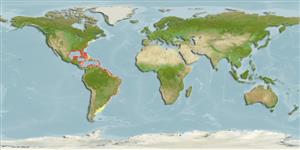Actinoptérygiens (poissons à nageoires rayonnées) >
Perciformes (Perch-likes) >
Gerreidae (Mojarras)
Etymology: Eucinostomus: Greek, eu = good + Greek, kyon = dog + Greek, stoma = mouth (Ref. 45335).
Environnement / Climat / Gamme
Écologie
; marin; eau douce; saumâtre récifal; profondeur 0 - 55 m (Ref. 26912). Subtropical, preferred ?; 43°N - 51°S, 98°W - 34°W
Western Atlantic: Massachusetts, USA and Bermuda to Argentina; including the Gulf of Mexico and the Caribbean Sea (Ref. 9626).
Length at first maturity / Taille / Poids / Âge
Maturity: Lm 11.0 range ? - ? cm
Max length : 25.5 cm TL mâle / non sexé; (Ref. 111768); common length : 15.0 cm TL mâle / non sexé; (Ref. 3722)
Épines dorsales (Total): 9; Rayons mous dorsaux (Total): 10; Épines anales 3; Rayons mous anaux: 7
Inhabits shallow waters, being especially abundant over mud bottoms in mangrove-lined lagoons or creeks; larger individuals may also occur on vegetated sand grounds in marine areas. Enters fresh water in limestone regions (Ref. 7251). May occur in aggregations (Ref. 3722). Probably feeds on small benthic invertebrates (Ref. 3722). Marketed fresh but not highly esteemed (Ref. 3722).
Life cycle and mating behavior
Maturité | Reproduction | Frai | Œufs | Fécondité | Larves
Robins, C.R. and G.C. Ray, 1986. A field guide to Atlantic coast fishes of North America. Houghton Mifflin Company, Boston, U.S.A. 354 p. (Ref. 7251)
Statut dans la liste rouge de l'IUCN (Ref. 115185)
CITES (Ref. 94142)
Not Evaluated
Menace pour l'homme
Harmless
Utilisations par l'homme
Pêcheries: intérêt commercial mineur; appât: usually
Plus d'informations
RéférencesAquacultureProfil d'aquacultureSouchesGénétiqueFréquences alléliquesHéritabilitéPathologiesTraitementMass conversion
Outils
Articles particuliers
Télécharger en XML
Sources Internet
